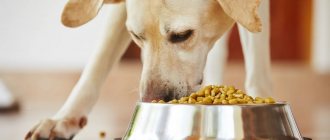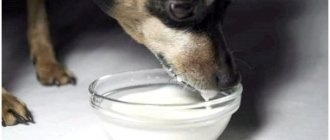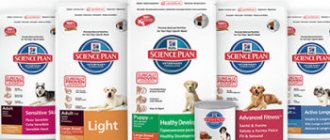Nutrition rules
How does digestion work in dogs? Of course, like a predatory animal. But, in addition to meat and bones, they need vegetables, fruits and herbs. Digestion should begin in the animal’s mouth, but the dog’s teeth can only crush pieces of meat and bones. They are not able to grind other types of food.
The gastrointestinal tract in dogs is short, compared to the gastrointestinal tract of herbivores - complete emptying occurs almost fifteen hours after eating. We can conclude that the stomach microflora for dogs is not as crucial as for herbivores.
But the bacteria that have settled in the cecum deserve a separate word - fermentative ones are especially necessary. It is their lack in the body that forces the animal to eat all sorts of disgusting, in our opinion, objects and creates a deficiency of vitamins in the body.
Conclusion:
- the structure of the dog’s gastrointestinal tract is designed by nature for nutrition, the basis of which (up to 80%) is raw meat;
- the composition of a single serving should be relatively small to prevent overeating and volvulus. Percentage of products: 75 – meat, 25 – cereals, sour milk, vegetables and fruits;
- the dog should be able to chew pieces of food to cleanse the mouth of bacteria, using secreted lysozyme and mechanically;
- bones must be digested by concentrated gastric juice - this indicates its health;
- Almost any meat is suitable for food, even wild animals. The main condition is low fat content;
- nutrition should be regular and balanced, taking into account health, age and physiological state.
Natural feeding
Natural feeding implies the most natural diet possible. Feeding with natural products involves three possible options:
- Raw food diet - feeding only raw foods.
- Meat porridge - feeding the dog a balanced mixture of heat-treated products.
- A mixture of raw and cooked foods is the most common type of feeding.
Important! Dogs are very different from their wild relatives and live in unnatural conditions, so the diet must be tailored to their needs.
Pros and cons of a natural diet
Let's look at the pros and cons of natural hair . Let's start with the advantages:
- Control over the freshness and quality of products.
- Taste variety.
- Possibility to control the caloric content of feed.
- The ability to choose a varied, tasty and gentle diet.
Negative nuances:
- Dog food needs to be prepared separately and regularly - time consuming.
- Products for cooking should be as natural as possible, for example, cottage cheese and other fermented milk products should be prepared at home from whole milk.
- Raw meat can become a source of helminth infection and should be cooked or frozen for 4–5 days.
- Natural food spoils quickly.
Note! Even the most balanced natural diet does not provide the dog with all the necessary vitamins and minerals, so the pet needs to take vitamin courses regularly.
Rules for feeding dogs with natural products
The basic rules of feeding natural products are balance. Statistically, most owners prefer to feed their dog meat porridge.
- For adult dogs, meat porridge is prepared from meat and offal, cereals, vegetables and fruits (33% each). Immediately before serving, vitamin supplements are added to the porridge.
- For puppies, the ingredients of porridge are similar, but the mass fraction of meat should be at least 50–60%.
Important! All foods that can cause allergies are introduced into the diet gradually.
There are many myths associated with milk, which is an important part of a dog's diet. Milk can and should be given to a dog if it tolerates it normally. Approximately 40% of adult dogs develop lactose intolerance, in which case whole milk is replaced with fermented milk products.
Prohibited Products
Prohibited foods in a dog’s natural diet are:
- Alcohol and its derivatives.
- Bones, pure fat, skin, especially poultry.
- Fat meat.
- Palm oil.
- Grapes, raisins.
- Citrus.
- Onion and garlic.
- Persimmon.
- Soy.
- Mushrooms.
- Corn and semolina.
- Raw freshwater fish.
- Dry, salted fish.
- Mayonnaise.
- Products containing hops, tobacco, sugar or its substitutes, xylitol (chewing gum, some sweets), flour or yeast (including yeast dough and dishes made from it), caffeine, cocoa, any stimulants (sweets, tea, coffee, chocolate) , marinades, salt, spices.
- Smoked products, including sausages, balyki, fish.
- Expired products.
- Cat food.
- Leftovers from the table.
You need to be careful with:
- Pork is a source of helminths.
- Raw ocean fish are a source of helminths.
- Whole milk – risk of intolerance.
- Honey is allergenic.
- Chicken eggs are allergenic.
- Raw and boiled chicken liver in large quantities can cause constipation or diarrhea (respectively).
Note! Peaches, plums and other juicy fruits are not prohibited, but can cause diarrhea. The bones can become stuck in the intestinal lumen, leading to obstruction.
An example of a proper menu made from natural products
The daily food intake for a puppy is calculated by weight. The weight of all the food that the baby eats per day should be 7–8% of body weight. For example, let's take the age from 1 to 3 months.
Feeding frequency:
- 1 month – 6 times a day.
- 2 months – 5 times a day.
- 3 months – 4 times a day.
Approximate calculation of food per day for a medium breed puppy aged 1–3 months:
- Meat and offal: 100–400 gr. – mass fraction of by-products no more than 15%.
- Cereals (preferably buckwheat, rice): 80–150 gr.
- Raw and boiled vegetables: 120–200 gr.
- Whole milk: 400–500 ml – in case of individual intolerance (extremely rare under the age of 3 months), milk is replaced with fermented milk products.
- Cottage cheese and fermented milk products: 100–200 gr.
- Chicken or quail egg: 1 chicken yolk or 2 quail eggs.
- Oils and additives: no more than 8 ml in total volume.
An example of the correct menu for a puppy aged 1 to 3 months.
- Early morning: cottage cheese with milk, you can add buckwheat cooked in milk.
- Morning: meat porridge - cereals, vegetables (carrots), meat, offal. Meat component 60%.
- Day: milk, cottage cheese, fermented milk products.
- Afternoon snack: meat porridge.
- Evening: milk porridge (buckwheat/rice/oatmeal) with grated apple, maybe a little kefir, yogurt or fermented baked milk.
- Evening: the meat is clean, raw, after deep freezing for 4–5 days.
Adult dogs eat 2-3 times a day.
For a medium-sized pet (25–30 kg), the approximate daily food intake is made up of:
- Meat and offal and/or fish: 400–500 gr. – by-products no more than 10–15%.
- Cereals (rice, buckwheat, oatmeal, pearl barley): 400–500 gr. – the calorie content of cereals is selected according to individual needs, but it is better to give preference to rice and buckwheat.
- Vegetables and fruits: 300–350 gr. – can be given raw, boiled, steamed.
- Chicken or beef fat: up to 20 gr. – can be replaced with fish oil (2-3 capsules).
- Vitamin supplements: 10–15 g. – can be replaced with industrial vitamin supplements in tablets.
Example menu for an adult dog No. 1:
- Morning: meat porridge – 300 gr. meat, 300 gr. cereals, 200–250 gr. vegetables, vitamin supplements.
- Evening: beef stomach, chopped, 200–350 gr.
Example menu for an adult dog No. 2:
- Morning: milk porridge – 250–300 gr. cereals, 1-2 small apples, chicken or 2-3 quail eggs, cottage cheese 100-150 gr.
- Evening: meat porridge – 300 gr. meat, 300 gr. cereals, 200–250 gr. vegetables, vitamin supplements.
Sample menu for an adult dog No. 3:
- Morning: fish and broth with vegetables (except potatoes) 400–550 gr. in total.
- Evening: raw meat or beef tripe 250–200 g, vitamin supplements.
Note! Due to breed characteristics, the above examples may not be suitable for your pet. Always create a diet based on the preferences and behavior of the ward.
To determine whether the dog is eating the offered portion, it is necessary to monitor the pet’s behavior immediately after eating. Typically, the dog actively absorbs food within 10–15 minutes.
- If there is food left in the bowl 20 minutes after the start of the meal, the portion is too large.
- If the dog finished eating in less than 10 minutes, the portion of food is not enough.
Water intake when feeding natural food
With natural feeding, the water norm is calculated based on the pet’s weight. The minimum daily water intake is 50 ml per 1 kg of body weight. Not drinking enough water can lead to problems digesting food and dehydration. Excessive thirst and water consumption is an alarming symptom.
Exceeding the norm of water consumption by 2 or more times, against the background of a good appetite, may indicate the development of diabetes. Strong thirst is also a symptom of purulent inflammation of the uterus and other inflammatory processes.
In any case, if your dog drinks much more water than he should, be sure to consult a doctor.
Dry dog food
There is a huge variety of manufacturers on the ready-made food market, who vying with each other to offer different types of diets, claiming that their food consists of 100% natural products.
Naturally, most often these are just publicity stunts. Let's figure out what types of feed are on the market.
Dry food is divided into classes: economy, premium and super-premium. Basic rule: you cannot feed your dog economy class dry food. Within a few years of eating this way, your pet will develop irreversible health problems. The funds saved in this way will have to be spent on restoring and maintaining the dog. Economy class food can be used only in the rarest cases: for a short time due to difficulties in purchasing good food. When purchasing a tailed friend, you need to be aware that its maintenance will require investments in food, treatment and other procedures.
Premium and super-premium dry food is recommended by veterinarians and owners. It is better to immediately choose super-premium food. As a rule, premium brands are liked more by pets, but this is often due to the use of aromatic additives, flavor enhancers, and salt.
Premium food contains a higher content of protein, fiber, and natural ingredients that can improve the dog’s digestion, reduce the smell of feces and correct health problems.
For each animal, food will have to be selected strictly individually. It is better to start by buying a small bag and buy it several times. Often dogs stop eating a certain type of food for no apparent reason, so you will have to find another one. Selection tips:
- Avoid choosing dry food with multi-colored granules;
- choose a diet with a granule size that will be convenient for your pet: not too large for the mouth, but not too small. It's better if you have to gnaw them rather than just swallow them. There are specialized foods for certain breeds, made in a convenient form;
- carefully study the composition and breed recommendations on the pack;
- Monitor your body's reactions and stop feeding immediately if they occur.
Remember - dogs need clean, fresh water at all times. A bowl of water should always be in an accessible place. In hot weather, the norm is increased, not forgetting to take the dog outside more often.
Advantages and disadvantages
| pros | Minuses |
|
|
Helpful information.
There is a lot of debate about what is better - natural food or food. Food advocates criticize natural food, while natural food supporters advocate in every possible way for the abandonment of dry food. We will not campaign on anyone's side. Feeding style is always the owner’s choice. But the choice must be conscious! It should not be based on false information, which is very common on the Internet. One can only guess where it comes from - perhaps it is distributed by feed manufacturers, perhaps these are some old myths. They are supported by many breeders, and, strangest of all, by many veterinarians. It is difficult to judge the reasons for this phenomenon. For some reason, veterinarians no longer consider dogs to be dogs. One reason may be that natural feeding is not easy to explain and requires a lot of information to be given to the patient. It is impossible to simply say that natural food is better, because there is a high chance that the patient will go and cook oatmeal for his dog.
So, it's time to dispel a few myths related to food and natural nutrition so that you can make the right nutrition choices for your furry friend!
?Natural food is difficult to balance, but the food is already balanced. This is always the main argument in favor of food. Now think about what balance is? This is the nutritional value of the food that is suitable for that particular dog. How can food be balanced specifically for your dog if it is all the same? ?With natural feeding you need to give good vitamins, but the food has everything - no need to give any additives. With proper natural feeding, the dog does not require any supplements. The dog's body is made in such a way that it receives all its vitamins from meat products. On the contrary, whether he gets enough from artificial, synthetic vitamins is unknown. ?Natural meat is difficult and takes a long time to prepare; not everyone has the time. Cooked, i.e. boiled meat with cereal, this is not natural! Natural food consists of raw meat, organs, bones and raw vegetables. There is no need to cook anything. Yes, preparing food for natural feeding will take more time than buying food and filling a bowl, but it will not deprive you of your weekends and free time in the evening. Especially if you have one tiny Pomeranian and not a 50 pound dog. ?Dry food does not form a stone because the dog chews it. This misconception does not stand up to criticism at all. Try it yourself; instead of brushing your teeth, chew on a bread cracker. ?Dogs should not eat raw meat, it contains parasites. Parasites are everywhere. In terms of the number of parasites, no meat can compare with the stick that your dog chews in the park or with its own paws, which it licks after a walk along the city streets. When a dog eats raw meat, a very high acidic environment is established in its stomach, and it is this that protects the dog from parasites, bacteria and protozoa that can be found both in the meat and in the environment. ?If you feed it meat, there will be protein poisoning. Will not be. When feeding raw meat, there is no excess protein, which can lead to protein poisoning. Protein poisoning is an excess of ammonia in the blood, which is formed when the mechanisms of ammonia detoxification during the absorption of proteins are disrupted. This is a serious disease that does not occur when the level of protein is simply exceeded; the body absorbs the protein it is accustomed to without any problems. Remember how canines eat in nature - once a week a huge amount of protein in the form of roe deer and no ammonia poisoning. When feeding cooked meat, care must be taken because the protein is different.
And now the real disadvantages of natural nutrition.
?For natural nutrition you need very high-quality products; chilled meat from the supermarket is not suitable, because it can be processed with something for storage. You need to look for clean farm meat; finding it in big cities is sometimes difficult and often not cheap. And if you have a Pomeranian, you can still afford it; with larger dogs, food can get expensive.
?You need a lot of space for storage, because you need a variety of products. You may need additional equipment - a blender or chopper, perhaps even an additional refrigerator!
?Transferring to natural raw feeding can be a very difficult process in some cases. It is very difficult not to give up and go back to feeding in the first months. It is explainable. The body of some dogs is so altered by the effects of dry food that they are simply unable to digest raw meat. Moreover, dogs that can immediately start eating raw meat after feeding without any problems are rather an exception. During the transition to raw meat, the dog’s body is completely rebuilt, returning to its natural state - this process can be traumatic, both for your dog and for you.
?Time for shopping and preparation. It takes everyone different amounts of time. Some people have to travel 200 km to get meat, others have it delivered to their home, others spend one day off a month preparing food - slicing meat and chopping vegetables. You can spend 5-10 minutes on this every day before feeding - in any case, this is your time.
?Trips. If the dog is on food, it is much easier to take his food with you on a trip. This does not mean that it is impossible to travel on a natural diet. It is possible, but it is much more difficult and requires some ingenuity.
Now about the positives. ✅Natural food is ideal for dogs with allergies. You always know what you are giving and how much, and you can easily figure out which product caused the allergy and simply remove it from your diet. ✅The immunity of a dog on natural food is hundreds of times stronger than on food. This is explained by the activity of the intestinal microflora. Dry food is a half-digested product, and with this diet, the dog’s gastrointestinal tract works as if at half capacity, and is in sleep mode. The body will not produce what it does not need. And in this case, it does not need such quantities of enzymes and flora to digest meat, and it is the intestinal flora that is responsible, in addition to digestion, also for immunity. Reduced microflora means reduced immunity. ✅In six months or a year, the problems with the housing complex that existed before will go away. Despite the difficult period of adaptation, when addiction is over, the dog’s gastrointestinal tract begins to work at full strength - acidity levels out, the necessary microflora appears. Problems such as dysbiosis, problems with the mucous membrane of the stomach and intestines, problems with acidity, sometimes even gastritis - all this gradually goes away. ✅Less tartar. Raw natural nutrition maintains the correct acidity and the correct composition of saliva, which prevents the formation of plaque and tartar. Bones help clean teeth. ✅Dogs are much more active and energetic, the condition of their coat and skin improves. On a natural diet, the dog receives more of the protein it is accustomed to, from which more energy is generated and which is used to build muscles. Vitamins obtained naturally affect both the well-being and the condition of the dog’s skin and coat. ✅Fighting excess weight. When fed raw meat, dogs rarely become overweight, because they receive protein that is familiar to their body, it is better absorbed, and goes into energy rather than into fat deposits.
Now that you know the truth about dry food versus natural feeding, you can truly decide which option is best for your dog.
Natural food
The main argument of defenders of natural food is that animals have been eating meat for centuries and have not known such problems with the health of internal organs, which began to be registered by veterinarians with the emergence of the industry for the production of dry ready-made food.
Natural food will require the owner to spend a long time selecting and drawing up a weekly menu. You should not think that you will be able to save money by increasing the amount of vegetables and cereals per serving and reducing the share of meat. This will only lead to your dog remaining hungry and starting to beg and steal food.
Supporters of natural medicine note that this type is more labor-intensive, but brings more health benefits: a lower percentage of diseases of the genitourinary system, kidneys, pancreatitis, teeth and gastrointestinal tract.
There is an opinion that “a balanced diet” is an advertising slogan that is imposed on the minds of owners by manufacturers of ready-made food. The basic rules for feeding animals:
- typical diet for a dog: basis – meat, necessary fermented milk products for colonizing microflora, fiber;
- moderation - the portion corresponds to the size and needs. Overeating and starvation should not be allowed.
These two points are typical for natural food, unlike dry food.
Naturally, you need to remember that there is a list of prohibited products, which includes:
- smoked, salted products;
- sweets;
- flour products;
- fat meat;
- dairy products.
You need to remember the need to purchase additional complexes of vitamins and minerals, since during the cooking process many of them lose their properties, and not all of them are absorbed in the process of eating food.
Advantages and disadvantages
| pros | Minuses |
|
|
Natural dog feeding
Does ready-made food still make you suspicious? Do you want to feed your pet what you prepared yourself? And that's not a bad thing. Your four-legged friend will appreciate such care. How to feed your dog natural food? Before creating a menu, please note: natural food for dogs should consist of 70% good fresh meat. But the remaining 30% may include plant foods. What kind of food will your dog be happy to find in his bowl? The dog must receive:
- meat and poultry;
- offal (stomach, lungs, kidneys);
- buckwheat, rice, millet and bran;
- grated or finely chopped fruits and vegetables;
- cottage cheese;
- raw eggs;
- vegetable oil;
- greenery;
- fish fat;
- mineral supplements.
The diet may vary depending on the breed. After all, each breed has its own proper feeding. Bones are very useful for dogs. From 4-5 months, puppies can safely be given this product. This way you will prevent the formation of tartar and strengthen your pet’s teeth. It is important that the bones are not boiled. Put a taboo on tubular and small bones - your pet can chew and swallow them.
Mixed nutrition
Most veterinarians and owners believe that this type is unacceptable. By mixed, many understand options in which dogs receive dry food in the morning feeding, and in the evening a portion of porridge with meat, or the products are mixed directly in one bowl. It is unlikely that any animal will be able to digest such a diet without causing serious problems with the gastrointestinal tract.
Many breeders have developed their own mixed type rules:
- dry food + meat products, fermented milk, vegetables or fruits in one bowl;
- Cereals are not used in such feedings.
Such nutrition will not create a significant burden on the gastrointestinal tract, since a dog needs different doses of acids and types of enzymes to digest dry food and porridge.
There are nurseries that use a mixed type, but with one caveat: dry food is soaked, meat is eaten boiled. If meat is given raw, this should be a separate feeding. For example, evening.
Interesting fact: dry food manufacturers themselves allow a mixed type of feeding - granules + wet canned food.
Advantages and disadvantages
| pros | Minuses |
|
|
Pros and cons of feeding natural foods
Pros:
- it is natural food for the animal;
- the ability to create an individual menu;
- confidence in the freshness of products.
Minuses:
- labor-intensive preparation and storage;
- high price for quality products.
It is strictly forbidden to use fragile and tubular bones, the fragments will damage the stomach
What to feed a dog, the opinion of veterinarians
There is no clear opinion among veterinary specialists regarding the choice of type of feeding; each of them proceeds from their own experience. Most of them select the patient's menu together with the owner.
Here are some opinions:
Ivan S, veterinarian, 8 years experience
“I suggest my clients start feeding their puppies with dry and wet food, choosing exclusively super-premium classes. From experience, some owners simply forget about the need for additional support of the body with vitamins when feeding natural food, or simply save on it. We often change dry food if problems arise or the pet refuses to eat one or another type. Using a ready-made diet, it is easier to choose a diet for obesity, or choose an option for an allergy sufferer or an older dog. In this option, the owners are more disciplined with their dog - they do not give food from the table.”
Elena K., veterinarian, 12 years experience
“I am a supporter of natural nutrition, with a high content of meat in dog food. Since the advent of dry food, the number of kidney diseases and urolithiasis has seriously increased. Problems with inflammation of the paraanal glands - feces are too soft in consistency. Naturally, natural food is only for owners who are ready for problems with nutrition. If I see that the pet has been switched to full plates of empty porridge with a small amount of vegetables, I recommend dry food.”
Oleg, veterinarian with 6 years of experience
“Even during our studies, we were told that a mixed meal option should not be recommended to owners, since the dog’s gastrointestinal tract simply cannot cope with the constant process of digestion. But with a competent approach, choosing the diet and system together, we came to the conclusion that mixed options are often an excellent solution. The dog will receive everything it needs. It will not burden the gastrointestinal tract and will avoid most of the problems inherent in the same type of feeding.”
How to feed your pet natural food
When the question arises about which dog food to choose - dry or natural, you need to focus not only on their age, but also on their preferences. Small puppies need to be fed approximately three to four times a day, because the growing body needs more energy and useful elements. In the case of adult individuals, the situation is simpler - two meals a day (breakfast and dinner) are suitable for them.
Natural food must be heated. Thanks to this, the pet will show more interest in it, and it will be absorbed faster. After all, in living nature, when a predatory animal kills its prey, it tries to consume the meat as quickly as possible before it gets cold.
Which is cheaper: dry food or natural food?
An important factor when choosing a type for the owner is cost. At first glance, the natural one looks cheaper. After all, the cost of super-premium dry food is quite high, and if the dog needs specialized food, it is even higher.
In natural nutrition, the most expensive product is meat, accounting for 75%. In regular stores, the cost of beef is very high. But don’t forget about another expense item – vitamin and mineral complexes. High-quality and balanced complexes are not cheap.
From the experience of dog breeders, it can be noted that the two types of feeding cost approximately the same amount. Natural wood costs a little more, but not significantly. At the same time it takes much more time.
Dry or natural: what to choose
Many dog owners, especially newbies, find themselves under information pressure when trying to choose the optimal diet for their dog. Having listened to advertising and advice from experienced dog owners, a novice owner becomes even more confused.
Dry or natural: what to choose? Which food is better and healthier? How do you know if your dog really likes the food?
- Feeding your dog naturally is more natural.
- Dry ready-made food is an alternative for owners who, for some reason, cannot feed their dog suitable natural food.
To be fair, we note that in some situations, feeding industrial products becomes the only alternative to provide your pet with a balanced diet.
How to switch your pet to dry food from natural food
Translation rules:
- You can’t do this suddenly at one feeding;
- At first, the granules are soaked in water, not forgetting to remove them after feeding to avoid spoilage;
- before transferring, calculate the volume of the daily portion and replace part of it with narrowed food;
- The daily portion is divided into 7 parts. The first three days give one part + 6 naturals, then every two days they increase the portions by one;
- if the dog does not want to eat dried meat, pieces of boiled meat are added to the portion, but not more than 10%;
- food is bought in small bags in case the dog refuses to eat this type;
- if the dog refuses to switch to drying, you should wait a while until the dog gets hungry;
Before such a transfer, visit a specialist to examine your pet; perhaps he has contraindications to such a food transfer.
Mixed feeding
Many veterinarians agree that dogs, like other pets, should not be kept on a combination diet. Mixed feeding is not the best nutrition choice for your pet. That is, you should not give your animal fresh food and industrial feed at the same time. If the dog receives ready-made food, you can alternate dry granules with patchouli, pates, mousses, pates, and canned food.
Important! Combination feeding often provokes chronic gastrointestinal diseases and leads to disruption of metabolic processes. This diet is not suitable for puppies, dogs with digestive problems, animals prone to food allergies, and elderly pets.
Be sure to alternate drying with canned food and wet food. You cannot feed dogs only dry or wet food. Use products from the same brand.
How to switch your pet to natural food from dry food
Rules:
- begin the transition to natural food with light foods that do not cause allergies: rice, turkey, beef;
- the transfer should last from 10 to 14 days;
- each new product is introduced every 2 days;
- start with one type of meat - better than turkey;
- after poultry, you can introduce beef;
- vegetables are gradually introduced, and on the 10th day, sour milk, fish and offal;
- It is better to postpone feeding meat until the evening, since it takes a long time to digest;
- with this transfer, one of the dog’s feedings is replaced.
What to feed your pet – dry food or natural food – is the owner’s choice. The main thing is that such feeding is typical and moderate and does not lead to serious health problems. Remember - you can’t skimp on your dog’s food. What do you feed your pet? What menu are you creating? What food do you choose? Share your experience in the comments, please.
The benefits of natural food
Before you figure out how to organize your dog’s nutrition, whether to feed it natural or dry food, and whether it’s worth switching your pet from one food to another, you need to learn about the advantages of each option. The first thing to consider is natural food.
All breeders know for sure that dogs cannot be fed from the table, and many of them are categorically against this. Quite often, owners pamper their pets with various delicacies when they sit down at the table. Of course, human food is different from dog food, since they are completely different diets. Such feeding would be extremely unwise and is unlikely to lead to anything good. In addition, after some time it will no longer be possible to accustom your pet to proper nutrition, even by mixing foods.
Feeding a puppy natural and dry food is a recipe for whims
Sometimes dry food is mixed with “natural food” to force a puppy suffering from poor or unstable appetite to eat. But in the long term, this method does not work, and sometimes leads to the opposite effect: the more you pamper the animal, the more capricious it becomes.
Food saturated with moisture smells much more intensely compared to dry food. When choosing food, dogs are guided primarily by smell, so if given a choice, they prefer meat and offal to pellets. By regularly pampering your puppy with natural treats, you risk that he will completely refuse dry food, while begging and whining pitifully during every master's meal. If this is not your plan, it is better to choose one type of feeding and stick to it daily.











